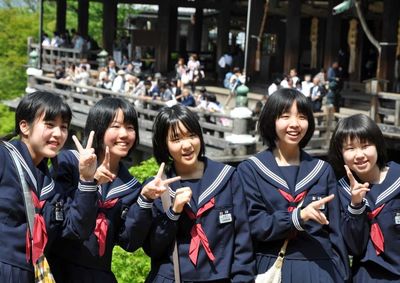An Overview of Common Challenges of ESL Students from Japan

Japan is a nation that has tried to increase its citizens' English ability, especially with the upcoming 2020 Olympic Games being held in their country. However, progress has been slow and not fruitful. There are various reasons for this slow stagnation of the nation's English abilities such as the larger academic system and access to proper education in rural areas. However, I will focus on three main hurdles that Japanese learners of English must face that can impede their English education.
Table of Contents
Do you want to teach English abroad? Take a TEFL course!
This post was written by our TEFL certification graduate Michael H. Please note that this blog post might not necessarily represent the beliefs or opinions of ITTT.
Japanese vs. English
These are the differences in phonology between Japanese and English, the lack of exposure to the Roman alphabet, and the traditional emphasis on written tests that do not allow for much student participation. I will be writing from personal experience as I have been teaching English in Japan (ages 6-15) for several years and have done research into this field. Japanese has limited phonology with fewer sounds than English and a rigid system for how consonants and vowels may be arranged.
Also Read: "How Using Songs May Be Beneficial for Your Teaching"
Phonetics
Firstly, Japanese lacks the following sounds written using the International Phonetic Alphabet: [ð], [j], [r] or [ɹ], [θ], [v], [Ê’], [æ], [ɪ], [ÊŠ], and [ÊŒ]. Additionally, [f] can only be followed by [uË] while [h] cannot; [dÊ’], [tʃ], and [ʃ] cannot be followed by [e], and [z] and [t] cannot be followed by [i]. [w] only exists as a diphthong between vowels starting with [ɯ]. On top of these sound limitations, the Japanese language has a very strict syllable structure of consonant-vowel (CV). The only exceptions to this are [n]/[Å‹] which can end a syllable and combinations of some consonants with [ja], [ju], or [jo]. This makes learning the much less restrictive English phonology a difficult task for many students.
Approximates are often used, and vowels are inserted between consonants where they do not normally occur. Even simple words such as "cat" [kæt] become almost unrecognizable as ['kjaʔto]. Many students are unable to properly hear and process sounds outside of the Japanese system, often confusing "l" with "r" and "b" with "v" and need to have words repeated using Japanese phonemes. This could be changed with better exposure, but there is little proper English pronunciation within the country outside of classrooms.

Also Read: How much can I earn teaching English abroad?
Alphabet
A second barrier for Japanese learners of English is the Roman alphabet. In daily life, Roman letters (or romaji) can be found on many signs and packages. However, they are intended to be purely decorative with no expectation of people actually reading them. The few exceptions are Japanese words written out in romaji, following the same strict rules as the Japanese language's phonology. Due to this, Japanese people are unfamiliar with how the Roman alphabet sounds and works outside of romaji. Oftentimes, even after being taught the alphabet, students are expected to simply memorize each new word's spelling with no explanation of how letters work together to represent sounds. This is similar to how they learn their own native words when written in Chinese-adapted characters (kanji) which often do not relate to pronunciation. A lot of time is spent teaching the very basics of the alphabet, leaving other English skills lagging, and ultimately achieving little as many students do not learn how to write anything outside of the Japanese language.
Japanese English Class
The third issue I would like to bring up is how the average Japanese English classroom functions during a regular class outside of elementary school. Most Japanese classes use a teacher-centric teaching style where students are only expected to take notes in class and do their homework at home. Participation and activation are not emphasized and often not utilized at all. This is the result of a long tradition of teacher-centred education in Japan. There are English teachers who may attempt to have students participate in class by asking questions, using conversation-focused activities, playing games, etc. However, as none of the other subjects' classes use these techniques, students are often uncomfortable with these unfamiliar techniques and will resist them by remaining silent or rebelling and causing distractions in class. Students often require very clear and rigid models to follow which they will use with no deviation as being asked to use their imagination (such as asking them to create their own sentences using a new grammar point) is completely unheard of in any of their other classes.
Also Read: Do TEFL teachers need a second language?
Style Problems
This style of education where one follows a model until they can regurgitate said model works well with the education system focused on passing national exams to progress into high school and university, but it does not lead to long-term learning and actual communication skills such as speaking and listening suffer the most. This is evident in Japan is ranked 49th in the world in English proficiency, falling behind other East Asian countries such as China, Taiwan, Vietnam, Hong Kong, and South Korea.
Do you want to teach English abroad? Take a TEFL course!
There are many challenges facing learners of English if they are from Japan. The Japanese phonology and syllable structure leads to a difficulty understanding the sounds available in English. The Roman alphabet is seen as something decorative rather than a tool used for communication, and spelling is thought of as something separate from pronunciation. In addition to this, the Japanese school system is not conducive to a language-learning environment, stifling imagination, and underutilizing student participation. The effects of these barriers along with others can be seen in the nations' poor English proficiency compared to its neighboring Asian countries. Though reform of the entire education system and cultural view of school would be needed to fix some of the problems facing Japanese English learners, new efforts are being put to use to try to improve national English proficiency.
Apply now & get certified to teach english abroad!
Speak with an ITTT advisor today to put together your personal plan for teaching English abroad.
Send us an email or call us toll-free at 1-800-490-0531 to speak with an ITTT advisor today.
Related Articles:
- 7 Fun Activities for Teaching Vocabulary in the ESL Classroom
- The Best Countries for Single Women to Teach English Abroad
- How to Legally Teach English in France With a Student Visa
- How Learning Chinese Made Me A Better English Teacher In China
- The 5 Best Places to Learn French When Teaching English Abroad
- The 7 Most Beautiful Cities in Italy for Teaching English Abroad




